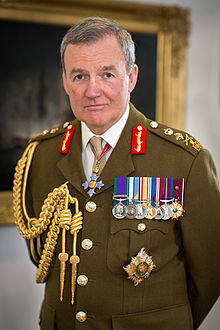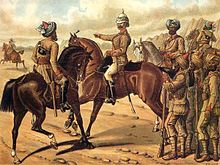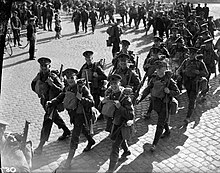Service Dress (British Army)

This article needs additional citations for verification. (September 2014) |
Service Dress is the style of khaki service dress uniform introduced by the British Army for use in the field from the early 1900s, following the experiences of a number of imperial wars and conflicts, including the Second Boer War. This variant of uniform continues to be worn today, although only in a formal role, as No. 2 Pattern dress.
Khaki

During the latter half of the nineteenth century, the bright red tunics worn by British infantry regiments had proved to be a liability, especially when during the First Boer War they had been faced by enemies armed with rifles firing the new smokeless cartridges. This had been exacerbated by the white cross-belts and ammunition pouches worn by the line infantry[1]
The term Khaki (
Service Dress
Other Ranks

For Other Ranks, the SD uniform originally comprised khaki wool (serge) trousers, a khaki wool tunic, with stand-and-fall (or Prussian) collar, four pockets on the front, each buttoned closed by a flap with a straight (horizontal) edge, large, serge reinforcement patches over each shoulder, shoulder straps and a pair of brass wire hangers on the back, over the kidneys, to support the belt.
Cavalry and gunners of the
Officers

The Officers' Service Dress was completely different, except in colour. The cloth used was tailored and of more expensive wool, and the tunic had longer skirts. After 1908 the turn-down collar was replaced by open stepped lapels. This created a jacket, similar to a civilian
Scottish Variations

Scottish Highland pattern uniforms differed in the wearing of tartan kilts or trews, rather than trousers or breeches and in alterations in the design of the tunic and jacket to make them resemble the traditional Highland doublet type – notably in cutting away the skirts at the front of the tunic to allow the wearing of a sporran. Most Scottish regiments did not wear the service dress peaked cap but either the Glengarry or Tam O'Shanter.
Tropical variation

There were also lightweight uniforms for wear in warmer climates, known as
Royal Air Force
The khaki Service Dress tunic adopted for the Royal Flying Corps (RFC) in 1912 had a wide cloth panel (a plastron) across the chest with concealed buttons, since it was thought that the usual button arrangement would be liable to catch on the bracing wires used on aircraft at that time. This tunic was popularly known as the "maternity jacket". The Naval Wing of the RFC, later the Royal Naval Air Service (RNAS), wore naval uniform.[14] On 1 April 1918, the RFC and RNAS merged to form the Royal Air Force (RAF). Initially, the uniforms of the former services continued in use, but on 1 May, an "interim" RAF uniform was approved which was basically the standard khaki Army Service Dress. A light blue version of Service Dress was approved for daily wear on 10 July, but this proved highly unpopular and many persisted with their old outfits. Finally, on 1 October 1919, the RAF Service Dress of a blue-grey colour, known as Air Force blue, was introduced.[15]
The Great War
This was the standard combat uniform of the British Army at the start of the
Although this was the standard combat uniform for the British Army and colonial units (at least when serving in temperate climates), the armies of the Commonwealth countries (which originally referred to those with Dominion status) had variations on the theme. The Canadian tunic was closed by seven buttons and had a conventional tunic collar (all stand and no fall), although the Canadian Officer's Service Dress was the same as that in the British Army. The Australian version of service dress, brought into use in 1912 and called the Commonwealth Pattern differed significantly. It was a lighter pea-green colour, had a voluminous pleat in the back, sewn-on waist belt, four large front pockets and triangular shaped upper pocket flaps.
Officers' SD uniforms were modified during the War chiefly in that plain cuffs were introduced, with the rank insignia moved to the shoulder straps. The reason for this was that the old cuffs had made it too easy for enemy snipers to distinguish officers from men. Scottish Highland regiments replaced the sporran during the war, with a khaki cloth apron with a large, buttoned pocket where the sporran would sit.
Kitchener's Blues
At the outbreak of war in 1914, the huge number of volunteers answering the appeal of
Great War gallery
-
Irish soldiers in Service Dress uniforms wait in a trench at the Somme, on the Western Front.
-
Field Marshal Haig, in Service Dress
-
26th Battalion of the Second Canadian Expeditionary Force, 1915. The Canadian OR tunic had a vertical collar and six buttons.
-
Bermudian officers and senior ranks of the Royal Garrison Artillery. Like the cavalry, Gunners did not wear 1908 Web Equipment, but retained the 1903 Bandolier Equipment.
-
Soldiers of the Bermuda Contingent of the Royal Garrison Artillery (Bermuda Militia Artillery) in a Casualty Clearing Station in July 1916
-
Major RC Earl & Lieutenant-Colonel RJ Tucker Bermuda Volunteer Rifle Corps, on Armistice Day, 1930, in warm weather and temperate officers' Service Dress
-
Soldiers of theLeicestershire Regimentin France in 1915, with their 1908 Web Equipment in Full Marching Order
-
An Australian recruit wearing the Commonwealth Pattern Service Dress in 1915
-
Canadian pilot Billy Bishop VC wearing the tunic adopted by the Royal Flying Corps in 1912. It had concealed buttons and was known as the "maternity jacket".
The Second World War

The Service Dress uniform continued to be the field uniform of the British Army until shortly before the Second World War, although many units continued to wear it after the start of hostilities and many Home Guard personnel wore it throughout the War. Service Dress was officially replaced as the standard combat uniform of the British and Canadian Armies in 1939, with the introduction of Battle Dress. Service Dress continued to be used by officers throughout the war, as a walking out dress and for semi-formal functions. Senior officers might rarely be seen in any other uniform. The Sam Browne belt had been replaced as carrying equipment for officers by the '37 Pattern web equipment but continued to be worn with the Service Dress, usually reduced to the belt and one brace (worn as a cross strap), though a frog or pistol holster might be added as needed).
The Australian Army continued to wear its version of Service Dress as its standard combat uniform throughout the war.
Current use
When Battle Dress was replaced with the green cotton
See also
- British Battledress
- British Army Uniform
- Dress Uniform
- Military uniform
References
- ^ Major R. M. Barnes, plate XIV and pages 257-258 "A history of the Regiments & Uniforms of the British Army", Sphere Books Ltd London, 1972
- ISBN 1-85753-243-0.
- ^ Major R. M. Barnes, pages 261-262 "A history of the Regiments & Uniforms of the British Army", Sphere Books Ltd London, 1972
- ISBN 978-0-74780-739-1.
- ^ Major R. M. Barnes, page 272 "A history of the Regiments & Uniforms of the British Army", Sphere Books Ltd London, 1972
- ISBN 1-85079-009-4.
- ISBN 1-85079-009-4.
- ^ "1903 Pattern Bandolier Equipment (set)". www.iwm.org.uk. Imperial War Museum. Retrieved 10 July 2017.
- ISBN 1-85079-009-4.
- ISBN 978-0747807391.
- ISBN 978-0007275489.
- ISBN 0-85045-898-6(pp. 56–57)
- ISBN 0-214-65349-8.
- ISBN 978-0750960052. (Chapter 3)
- ISBN 978-1909808027.
- ISBN 978-0857500595(p. 100)
- ISBN 978-1783461769(p. 81)
- ISBN 978-0750964951.











